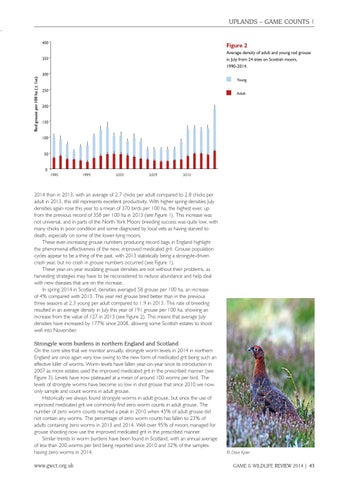UPLANDS – GAME COUNTS | 400
Figure 2 Average density of adult and young red grouse in July from 24 sites on Scottish moors, 1990-2014.
Red grouse per 100 ha (Âą 1se)
350
300 Young 250
Adult
200
150
100
50
0 1990 1995 2000 2005 2010
2014 than in 2013, with an average of 2.7 chicks per adult compared to 2.8 chicks per adult in 2013, this still represents excellent productivity. With higher spring densities July densities again rose this year to a mean of 370 birds per 100 ha, the highest ever, up from the previous record of 358 per 100 ha in 2013 (see Figure 1). This increase was not universal, and in parts of the North York Moors breeding success was quite low, with many chicks in poor condition and some diagnosed by local vets as having starved to death, especially on some of the lower-lying moors. These ever-increasing grouse numbers producing record bags in England highlight the phenomenal effectiveness of the new, improved medicated grit. Grouse population cycles appear to be a thing of the past, with 2013 statistically being a strongyle-driven crash year, but no crash in grouse numbers occurred (see Figure 1). These year-on-year escalating grouse densities are not without their problems, as harvesting strategies may have to be reconsidered to reduce abundance and help deal with new diseases that are on the increase. In spring 2014 in Scotland, densities averaged 58 grouse per 100 ha, an increase of 4% compared with 2013. This year red grouse bred better than in the previous three seasons at 2.3 young per adult compared to 1.9 in 2013. This rate of breeding resulted in an average density in July this year of 191 grouse per 100 ha, showing an increase from the value of 127 in 2013 (see Figure 2). This means that average July densities have increased by 177% since 2008, allowing some Scottish estates to shoot well into November.
Strongyle worm burdens in northern England and Scotland On the core sites that we monitor annually, strongyle worm levels in 2014 in northern England are once again very low owing to the new form of medicated grit being such an effective killer of worms. Worm levels have fallen year-on-year since its introduction in 2007 as more estates used the improved medicated grit in the prescribed manner (see Figure 3). Levels have now plateaued at a mean of around 100 worms per bird. The levels of strongyle worms have become so low in shot grouse that since 2010 we now only sample and count worms in adult grouse. Historically we always found strongyle worms in adult grouse, but since the use of improved medicated grit we commonly find zero worm counts in adult grouse. The number of zero worm counts reached a peak in 2010 when 45% of adult grouse did not contain any worms. The percentage of zero worm counts has fallen to 23% of adults containing zero worms in 2013 and 2014. Well over 95% of moors managed for grouse shooting now use the improved medicated grit in the prescribed manner. Similar trends in worm burdens have been found in Scotland, with an annual average of less than 200 worms per bird being reported since 2010 and 32% of the samples having zero worms in 2014.
www.gwct.org.uk
Š Dave Kjaer
GAME & WILDLIFE REVIEW 2014 | 43
